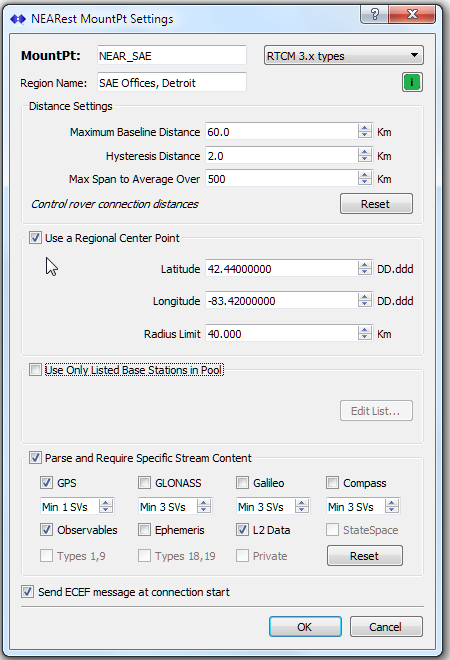Stream Contents Group

In this article we discuss the various stream content filtering controls used in the Nearest MountPt Dialog.
The required stream content section provides a means to select only those Base Stations that provide certain data types to be considered for a given NEAR pool.
The primary use of each of these controls is as follows:
Parse and Require Stream Contents (only parsed streams are considered)
This is the master check box for this group. It must be checked for any of the below items to apply.
The Required Stream Content option is used to allow only those Base Station streams with certain message contents to be used in the pool.
When Enabled: The message contents of all Parsed Base Stations falling within the defined region (if a region is present) are further examined. Only those data streams which contain AT LEAST the checked items are added to the pool. Any Base Station streams without the checked content will be excluded from the pool. This allows a precise control of the pool members. [Note: Parsing must be enabled on a stream for it to be considered.]
When Disabled: All Base Stations (parsed or not) falling within the defined region (if a region is present) are added to the pool. This is useful if the pool needs to contain Base Station streams which are sending with proprietary formatted data such as CMR+ which SNIP does not directly read. It has the drawback that not all the NTRIP Client rover devices may be able to handle these other non-standard content formats.
Note: When in the disabled mode, likely streams are selected based on the format type found in the their Caster String entries. There streams are not parsed and may not contain what their their Caster String entry indicates. When considering such streams for a NEAR pool, only the format type and the rough LLH (also found in the Caster String entry) are used.
The checked items shown in the inset image are simply typical, and would allow streams that a) have GPS data (note that GPS+GLO is not prohibited by this setting), b) contain raw measurement data, and c) also contain L2 carrier information.
GPS Check box
When checked the data stream must contain messages for the GPS GNSS system.
GLONASS Check box
When checked the data stream must contain messages for the GLONASS GNSS system.
Galileo Check box
When checked the data stream must contain messages for the Galileo GNSS system.
Compass (BeiDou) Check box
When checked the data stream must contain messages for the Compass GNSS system.
SV counts Values
Each of the above GNSS systems can also be selected or rejected based on the count of SVs it is tracking for that specific GNSS type. If a Base Station is tracking less then the indicated number, it is rejected form the pool. This also serves as a simple integrity threshold because to serves to prevent a Base Station with marginal data from being used.
Observables Check box
When checked the data stream must contain raw observables data (as opposed to only orbital data or some other data product such as clock corrections).
Ephemeris (Orbits) Check box
When checked the data stream must contain raw Ephemeris data (as opposed to observables data or some other data product such as clock corrections).
L2 Data Check box
When checked the data stream must contain information on both L1 and L2 measurements.
State Space Check box
When checked the data stream must contain the newer state space messages defined in RTCM3.x
RTCM 2.x Types 1 or 9 Check box
When checked the data stream must be of the RTCM 2.x type and contain either Type 1 or Type 9 messages (older style DGPS messages). This option is on value only with RTCM2.x streams. It is only operational in Enterprise mode.
RTCM 2.x Types 18 or 19 Check box
When checked the data stream must be of the RTCM 2.x type and contain either Type 18 or Type 19 messages (very early RTK messages formats, used with older equipment). This option is of value only with RTCM2.x streams. It is only operational in Enterprise mode.
Private Check box
When checked the data stream must contain either private messages in the range which is defined and assigned by RTCM3.x (4001 and above) or “testing” messages in the range below 100. It is only operational in Enterprise mode.
Determining the Pool contents with the tool-tip
When each NEAR stream is displayed in the Nearest tab, you can hover the mouse over the top or bottom cells of that entry and a tool-tip will appear listing which streams are part of the pool (as well as this that are not). An example of this is shown in on the Nearest tab page.
Right-clicking on any NEAR stream and selecting “Display Users” will place a textual summary of that NEAR stream into the console. The check box “Verbose” on the Nearest tab is used to control the level of detail provided.
Pressing the List Users button on the tab will produce this report for each of the NEAR streams.
The current client information (as well as the Base Stations used in the pool) can also be displayed visually with the View Map button on the Neatest tab.
The other controls used in the Nearest MountPt Dialog are described here.
